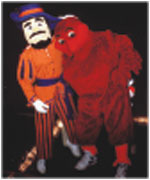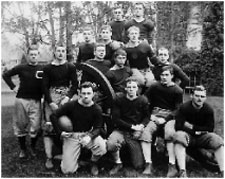Statewide campuses The two universities have been investing in cooperative academic ventures for years. For instance, because adults across the commonwealth often need educational programs specially designed to fit their needs, Virginia Tech and U.Va. occupy several shared facilities and work together in numerous educational endeavors. The Northern Virginia Center and the Richmond Center grew out of the need for Virginia Tech and U.Va. to provide graduate education in those areas, says Roger Avery, senior associate dean of the Graduate School. According to John Dooley, vice provost for outreach and international affairs, in Northern Virginia, the two schools share facilities, the library, a bookstore, and the latest digital capabilities, and offer graduate courses by bringing professors to the site and beaming courses to other areas of the state. At the Richmond Center, the schools, along with Tech's Cooperative Extension/Agricultural Experiment Station Division, share a building. Two other centers, independent agencies of the Commonwealth of Virginia, facilitate the collaboration of several state institutions at their sites, Dooley says. The Southwest Virginia Higher Education Center in Abingdon was created by the state to "strengthen the economy of Southwest Virginia through education and training of the workforce," according to its website. Virginia Tech operates its Southwest Virginia Center there, as do U.Va. and several other universities, allowing working professionals to complete graduate-degree programs or classes from nationally ranked programs and to receive degrees or certificates. The same is true at the Roanoke Center; however, "all the places have a slightly different flavor," Avery says, and they also offer courses in a variety of disciplines. Recently retired Tech Executive Vice President and Chief Operating Officer Minnis Ridenour, who was instrumental in securing funding for the Northern Virginia Center and has been active in the charter-university initiative, says, "U.Va.'s and Virginia Tech’s skills, capabilities, and programs complement each other at our off-campus programs. These centers enable us to provide educational opportunities at the times and places professionals and other students can take advantage of them." Preserving the South Atlantic culture In 2002, the South Atlantic Humanities Center (SAHC)--after extensive competition with other institutions for funding from the National Endowment for the Humanities--was created to explore and celebrate the differences that give each locality its unique identity, as well as to understand the commonalities that bind communities together as a region. The center, headquartered in Charlottesville, serves Florida, Georgia, North Carolina, Puerto Rico, the Virgin Islands, and Virginia and "represents a groundbreaking partnership among Virginia Tech, the University of Virginia, and the Virginia Foundation for the Humanities through its emphasis on the humanities," says Anita Puckett, Virginia Tech planning project coordinator. "The center is supported by its endowments and externally funded programs." By using the resources of all three institutions, the SAHC supports academic research, public programming, publications, media presentations, and K-14 educational projects that show the people and communities of the U.S. South Atlantic as being constituents of a complex region. "In so doing, the center brings to the foreground Virginia Tech's humanities contributions and places the university in a mutually beneficial relationship with two highly recognized humanities organizations," Puckett says. Managing natural resources The Virginia Natural Resources Leadership Institute, another cooperative effort between Virginia Tech and U.Va., is aimed at improving the capacity of commonwealth citizens, businesses, communities, and public officials to discuss and resolve issues concerning the management of Virginia's natural resources and the quality of Virginia's environment. The institute, sponsored by U.Va.'s Institute of Environmental Negotiation, Virginia Tech's Center for Economic Education, and the Virginia Department of Forestry, helps people who work with such natural-resource issues as water quality and supply, human and animal waste management, and urban and rural forestry. Improving health One of the main goals of a research university is to solve society's problems, and Tech collaborates with U.Va. on a number of projects to meet that goal: • David Kingston of Virginia Tech works with researchers from U.Va., the University of Pittsburgh, and Galileo Biosciences in California on a project aimed at discovering new anti-cancer agents from the natural world--in particular, plants and marine sources. This team makes up one of several National Cooperative Drug Discovery Groups funded by the National Cancer Institute. • Virginia Tech's Craig Nessler and researchers from U.Va.'s medical school are trying to express from plants a protein that is missing from stomach cancers. If successful, the team will then determine whether the protein can be used in prevention and treatment of cancer. • Fabricio Medina-Bolivar of Virginia Tech and U.Va. scientists are working to develop plant-based vaccines that can be taken orally or nasally to stop the parasite Entamoeba histolytical, which kills thousands of children in third-world countries. Also, the two schools have joined with Virginia Commonwealth University, through the Commonwealth Technology Research Fund, to form the Virginia Consortium for Mucosal Therapy of Infectious and Autoimmune Diseases to make plant-based nasal vaccines targeting gonorrhea and periodontitis, an advanced stage of gingivitis. Pulling together Recently, the most visible collaboration between the two schools, along with the College of William and Mary, is the attempt to persuade the General Assembly to create charter-university status for all three institutions. In exchange for fewer state dollars, commonwealth-chartered universities would have more control over their revenues but would remain public institutions accountable to the state. The 2005 General Assembly will address the issue, which many believe will save money. "Preservation of quality lies at the heart of this proposal," according to Tech President Charles Steger. "Virginia schools have, over the past several decades, built a national reputation for excellence and value. But they cannot continue to live on reputation alone. Investments are needed now." Working toward charter status: profitable partnerships, promising future "Strategic academic partnerships," says Steger, "are imperative for our future because the barrier to entry, or start-up cost, for new research or scientific programs is so high. Partnerships help us develop new programs without the staggering financial investments of going it alone." Virginia Tech has partnerships with several other universities--such as the School of Biomedical Engineering and Science's collaboration with Wake Forest University--but it has found a great deal of success in working with its athletic rival to the northeast. "The collaborations with the University of Virginia help us not only develop research partnerships, but also, through our satellite campuses, bring the benefits of those programs to the entire commonwealth," Steger says. "We want to see these programs grow and become major forces in the state, the nation, and the world."
|

